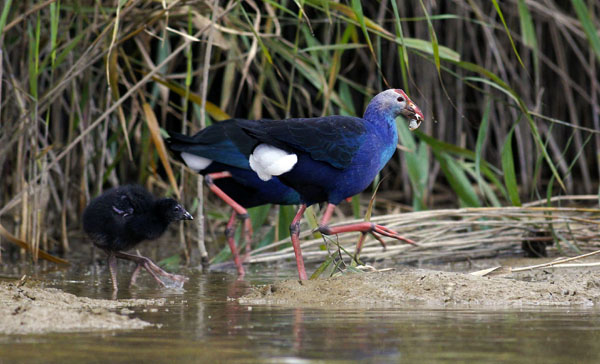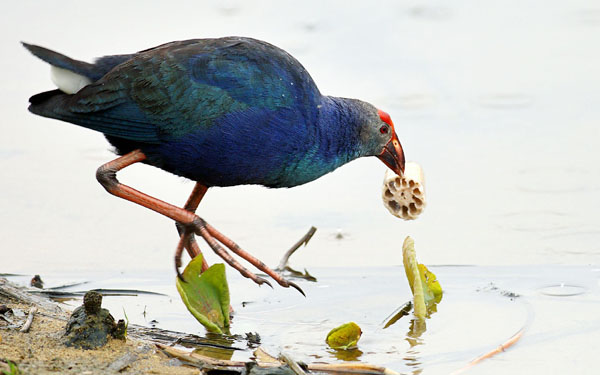Porphyrio indicus
IUCN
LCBasic Information
Scientific classification
- name:Porphyrio indicus
- Scientific Name:Porphyrio indicus,Black-backed Swamphen,Rodhoue Purple Swamphen, Reunion White Dodo
- Outline:Wading birds
- Family:Gruiformes Railidae P.Swamphen
Vital signs
- length:About 44 cm
- Weight:550g
- lifetime:
Feature
The whole body is covered with purple feathers, and it looks beautiful.
Distribution and Habitat
In China, it is only found in the western and southwestern regions of Eryuan, Tengchong, Luxi, Gengma, Xishuangbanna, Yunnan, and very few areas in Fujian.
It lives in swamps and reeds around rivers and lakes. It feeds on insects, mollusks, aquatic plants, etc.
Appearance
The sexes are similar, with the female being slightly smaller. The body feathers are mostly purple or blue, the undertail coverts are white, and the wings and chest are blue-green.
Details
Purple moorhen is a bird of the family Raccoon of the order Gruiformes. It is purple in color and lives by the water all year round. It is of medium size, with a short tail and a very bright red crown on its head. It looks very similar to a domestic chicken, so it is named purple moorhen. However, the beak of the purple moorhen is very large and wide, almost accounting for half of the length of its head.

Purple moorhen is gentle and timid. It likes to live in family groups. It is active in the early morning and dusk and hides in the reeds during the day. It is noisy when active, and frequently makes "click, click" and "hum" sounds. Good at walking and running on the ground, walking with slow and steady steps, often wading in shallow water, climbing on reed stems, or walking and resting on plants or leaves floating on the water. Not good at flying, generally rarely flying, and rarely swimming. When forced to fly, it will not fly far and fall down. When flying, the two wings flap slowly, and the long legs hang behind, which looks clumsy.
It is an omnivorous animal, mainly feeding on plants, eating the tender branches, leaves, roots, stems, flowers and seeds of aquatic and semi-aquatic plants. Animal food accounts for a small part, including mollusks, leeches, small crabs, insects and their larvae, spiders, fish and fish eggs, frogs and frog eggs, lizards, snakes, birds and bird eggs and chicks, small rodents and carrion. It often forages by the water, on floating plants or in rice fields, and can grab and tear food with its front toes, or move stones and turn plants with its beak.

It is a resident bird, but there is a seasonal local migration phenomenon with changes in habitat conditions. In some areas, it will migrate south in winter.
The number of purple moorhens in China is extremely rare. It is only found in western and southern Yunnan and a few areas in Fujian. It is a world-class endangered bird and has been very rare all over the world since the 19th century. Among them, the South China subspecies was first discovered in Xiamen in 1868, and Xiamen became the model origin of the South China subspecies of purple moorhen. However, after 1900, purple moorhens did not appear in Xiamen for about a hundred years.
But later, photography enthusiasts discovered that purple moorhens appeared in Xiamen. Before 2006, there were only 15 records of black-backed purple moorhens in my country. In 2012, the Xiamen Bird Watching Association announced that black-backed purple moorhens were found again in Xinglin Bay. In 2016, a breeding group of black-backed purple moorhens was found in Zhangdai Bridge Reservoir in Xiang'an, Xiamen, which attracted great attention from relevant parties.
For more than a century, the existence of purple moorhens could not be confirmed in Guangdong Province. Until 1997, purple moorhens were observed in the wild in Haifeng, Guangdong, thus confirming the existence of the species in Guangdong. Since then, the Haifeng Gongping Lake Provincial Nature Reserve (now the Haifeng Bird Provincial Nature Reserve) has been established to protect the purple moorhen. The purple moorhen lives and breeds in the reserve and the number increases year by year. According to statistics, the population of purple moorhen in the reserve is more than 200.
Listed in the second level of the "List of National Key Protected Wildlife in China".








